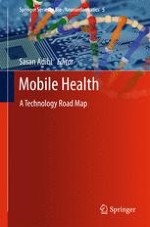2015 | OriginalPaper | Buchkapitel
Design Guidelines for Wireless Sensor Network Architectures in mHealth Mobile Patient Monitoring Scenarios
verfasst von : Manuel Casillas, Salvador Villarreal-Reyes, Ana Lilia González, Edwin Martinez, Aldo Perez-Ramos
Erschienen in: Mobile Health
Aktivieren Sie unsere intelligente Suche, um passende Fachinhalte oder Patente zu finden.
Wählen Sie Textabschnitte aus um mit Künstlicher Intelligenz passenden Patente zu finden. powered by
Markieren Sie Textabschnitte, um KI-gestützt weitere passende Inhalte zu finden. powered by
Mobile patient monitoring has been widely recognized as a viable solution to improve the quality of patient care and decrease health care costs. Depending on the mobile patient monitoring scenario and the patient pathology, it may be necessary to monitor different bio-physiological variables by means of specialized sensors. The information collected by these sensors is sent to the healthcare provider for its analysis, processing, and storage. Thus, the collected data can be used for remote diagnosis, ambulatory patient monitoring and to trigger emergency services. In mobile patient monitoring systems it is common to use wireless network technologies to transmit the data generated by the sensors, thus defining a wireless sensor network (WSN). The implementation of the WSN is not a trivial task, as different application scenarios have different requirements in terms of the number of variables to monitor, the number of supported users, mobility, data loss tolerance, power consumption, and coverage range, among others. All these requirements must be considered when designing the WSN architecture to be used in a particular mobile patient monitoring system.
There are several network architectures and wireless technologies that can be used for the implementation of WSNs in mobile patient monitoring scenarios. Thus, the main wireless technologies that can be used for this purpose are reviewed within this chapter. Then, the advantages and disadvantages offered by homogeneous and heterogeneous WSN architectures are discussed and analyzed by comparing performance metrics for a particular application scenario. Lastly, several guidelines for the proper design of WSN architectures in mHealth mobile patient monitoring scenarios are provided.
